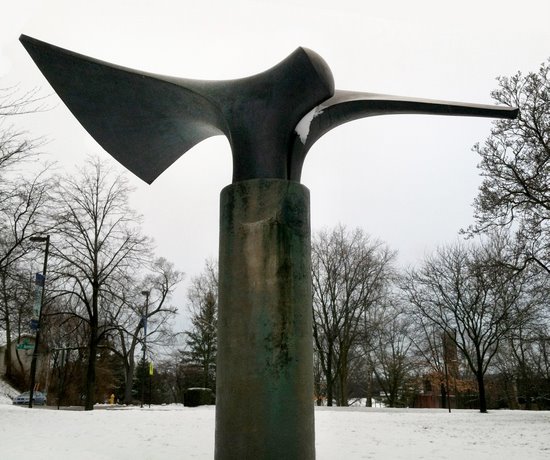Karoly Veress' sculpture Freedom is paradoxical: Its wing-like forms are ascending and graceful from some vantage points, yet they look like ax blades from others. Delving into the lives of the artist and the humanitarian who inspired this work, though, we can begin to understand that these elements aren't as contradictory as they first seem.
Dedicated in 2000, Freedom is located on the Augustana College campus, near the Denkmann Memorial Building at 3520 Seventh Avenue in Rock Island. Cast in bronze from a plaster model, it rises from a cylindrical concrete base to an overall height of about 10 feet.
The dynamic upper portion of the sculpture unfurls boldly into two fluid forms - giving the work its sense of motion. Veress explained: "In this design I symbolize freedom in wings, partly protecting, and sheltering, but foremost enabling us to rise above the daily confusions. These wings sometimes lift us up out of the monstrous historic context into a state where all that remains is just one commitment: to human values, to the dignity of all human beings."
Veress' words stem, in part, from his own experiences. The artist was a student at the University of Budapest while the city was still in postwar ruins and under Soviet occupation. When the 1956 Hungarian Revolution failed, he fled to safety in the Netherlands, where he would discover his love for sculpting.
The artist, however, said that his work was inspired by Raoul Wallenberg, who is widely credited with rescuing 100,000 Jews during the Holocaust. Wallenberg served as a Swedish special envoy in Nazi-occupied Budapest in 1944. He used his position to shelter Jews, issue protective passports, and prevent a planned massacre at the last moment.
His driver, Sandor Ardai, has told of Wallenberg intercepting a trainload of Jews as it was about to depart for Auschwitz: "He climbed up on the roof of the train and began handing in protective passes through the doors, which were not yet sealed. He ignored orders from the Germans for him to get down; then the Arrow Cross men [Hungarian fascist soldiers] began shooting and shouting at him to go away. He ignored them and calmly continued handing out passports to the hands that were reaching out for them. I believe the Arrow Cross men deliberately aimed over his head, as not one shot hit him, which would have been impossible otherwise. I think this is what they did because they were so impressed by his courage. After Wallenberg had handed over the last of the passports, he ordered all those who had one to leave the train and walk to the caravan of cars parked nearby, all marked in Swedish colors. I don't remember exactly how many, but he saved dozens off that train, and the Germans and Arrow Cross were so dumbfounded they let him get away with it."
Wallenberg evaded the Nazis by moving from house to house as the war was ending, but he was eventually seized by the Russian Red Army in 1945. Though Soviet authorities reported that he died of heart failure in prison in 1947 - and they later stated that he had been executed - there were credible and independent sightings of him in the Soviet gulag as late as 1987. Despite decades of Swedish, Israeli, and American diplomatic efforts to learn the truth, his exact fate remains unknown.
It is fitting that this sculpture is located at Augustana College, which was founded by Swedish Americans. Its location is even more meaningful, as the Denkmann Memorial Building houses Wallenberg Hall - an auditorium named in honor of the Wallenberg family.
Taken at face value, the sculpture is celebratory - a remembrance of the rescue of many tens of thousands of people by the actions of a single man. Yet the blade-like edges of the gunmetal-colored sculpture remind us that millions were not sheltered under the wings of freedom. We are also reminded that Wallenberg - only 34 years old when taken by the Soviets - likely died a prisoner. Freedom evokes a sense of shelter, but also of an unreachable dream.
Bruce Walters is a professor of art at Western Illinois University.
This is part of an occasional series on the history of public art in the Quad Cities. If there's a piece of public art that you'd like to learn more about, e-mail the location and a brief description to BD-Walters@wiu.edu.











